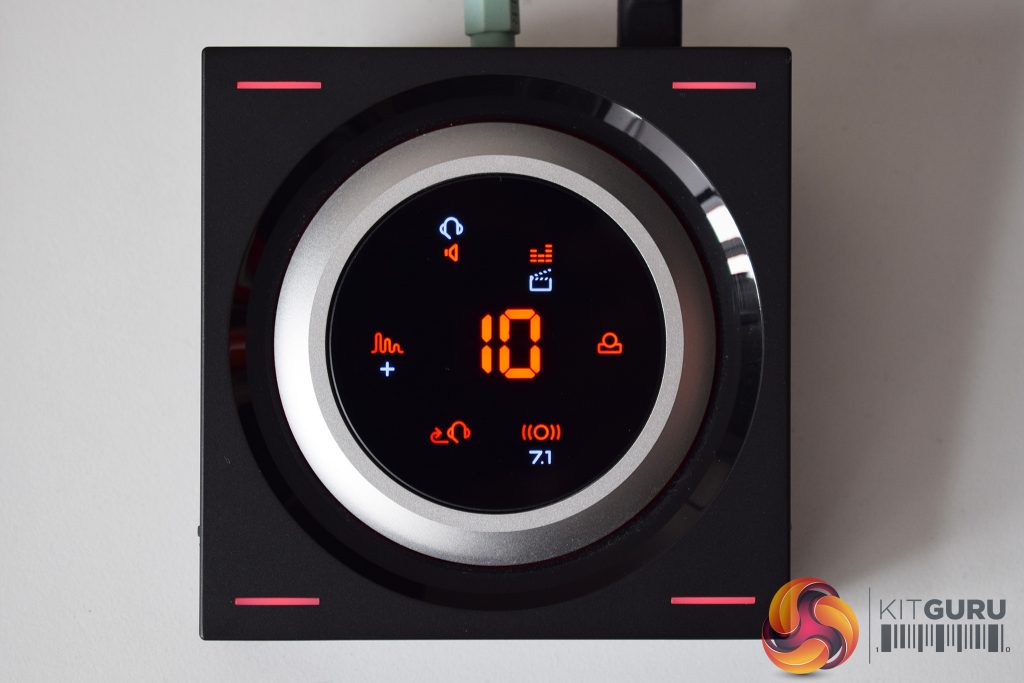To test the GSX 1200 Pro, I used it as my primary audio input – meaning I used it with my speakers and headphones to listen to music, watch videos and play games. I also connected a second GSX 1200 Pro to test out chat link, and see if it lives up to its name.
On-screen controls
First, let's assess the on-screen controls of the GSX 1200 Pro. These are identical to the GSX 1000's controls, but it is worth looking at.
Starting with the large number in the middle, this is of course the volume indicator. Turning the metallic wheel adjusts the volume in a quick and easy way, so that is all very straightforward.
Positioned around the volume indicator are 6 smaller symbols, each with their own meaning. Starting with the small headphones symbol (at 11 o'clock), touching this part of the screen will adjust what the amp outputs to – so if you have headphones and speakers connected, like I did, you can easily change the output destination without faffing around in Windows playback devices. It's a very nice touch.
Moving round to the right, the next symbol is EQ. Here there are three different presets – eSports, music or movie, while you can also disable the EQ as well. In practice, the eSports preset drastically reduces the amount of bass, and increases the treble, presumably to allow footsteps to be easily detected. Both movie and music modes sounded quite similar to me, and both just upped the amount of bass. My preference is to stick no with no EQ, but the option is there.
The next symbol, a small person, is for use with the virtual surround-sound, as it slightly alters the direction of the sound – you can choose between having the sound emphasised in front of you or behind you. I preferred to leave this ‘off' as well.
After that, we have the surround-sound switch, and this can only be used with headphones, but it just switches between the 7.1 and 2.0 channels.
Next, we have sidetone – this just gives two options for ‘low' or ‘high' mic sidetone, and this is particularly useful in loud environments as it lets you hear yourself clearly.
Lastly, we have what Sennheiser calls the ‘environment'. Essentially, this controls the amount of reverb applied to the virtual surround-sound, with ‘low', ‘high' or ‘off' settings being on-hand. Sennheiser reckons ‘high' reverb works well for open-world games as it can increase the overall ‘size' of the audio, but my preference was still to leave it off to preserve the most detail.
GSX 1200 Pro in use
Now that we have gone through all of the controls, what is the amp like to use?
I'll start with the virtual surround-sound, as this is perhaps the most impressive aspect of the amp. In short, this is undoubtedly the best implementation of virtual 7.1 I have ever used.
This is because the GSX 1200 Pro is able to enlarge the audio, and create the feeling that the sound is truly coming from all angles, in a very convincing manner – one that feels much more accurate, and also more detailed, than other attempts at virtual surround that I have heard.
Of course, it is still not quite as good as the real deal – for that you will need something like the ASUS ROG Centurion – but for virtual surround, I am very impressed.
Moving on, it is worth touching on the overall quality of the amp and the sound it produces. Here, I used a range of headphones – including the Beyerdynamic DT 990s, Sennheiser HD 598 Cs and Phillips Fidelio X2s – and gaming headsets with the amp to see what the sound is like.
First of all, the sound is much cleaner than when plugged into my motherboard's on-board audio. I would imagine this would be especially apparent for those of you who currently user older motherboards as on-board audio codecs have come a long way. Even with my relatively recent X99 motherboard I still noticed a big reduction in background interference which gives a much cleaner sound.
There are limits, though, and the GSX 1200 Pro should not be considered an audiophile-grade amplifier. For starters, it is recommended to use headphones with impedance of no more than 150 Ohms – so flagships from the likes of Grado or Sennheiser won't sound as good as they should. On-top of that, compared with my Fiio E10K – an entry-level audiophile DAC/amp, I do think that the GSX 1200 Pro does sound slightly more distant overall – not nearly enough to put me off using it, but if I were picking something purely for music/video consumption, I would probably go with the Fiio.
Still, the GSX 1200 is definitely a gaming device, and considering the several good features on offer, I was more than happy to use it for music and gaming – I've already said how much I enjoyed the virtual surround-sound, but even with 7.1 disabled, the amp still gives plenty of volume and detail in-game.
Chat link and mic
Since a big feature of the GSX 1200 Pro is chat link – the ability to talk directly to up to 8 different GSX 1200 Pros – it is only fair to talk about how this works and what it sounds like.
Essentially, all you need to do is connect your GSX 1200 Pros to each other using the included 2m chat link cable (it's a 2.5mm to 2.5mm cable). Each amp has two ports on the back, labelled ‘A' and ‘B'. The cable should go from port A on the first unit, to port B on the second unit. You can continue this for up to 8 units.
This feature is clearly aimed at eSports teams who need to talk to each other in real time, and it seems pretty straightforward. I could only test it out using just two units, but I got a clear audio signal and noticed no discernible lag – a definite benefit of this hardwired solution. Obviously, though, you all need to be within 2m of each other for this to work effectively.
The GSX 1200 Pro also uses an integrated noise-cancelling algorithm which could help teams competing in big and noisy arenas. However, if you are using the amp to game at home – in a relatively quiet environment – it does have the affect of adding a strong twang to the audio. To demonstrate this, take a listen to my recording where I compare the Sennheiser Game Zero's mic when plugged into the GSX 1200 Pro, and when plugged directly into my motherboard:
Game Zero mic comparison using the GSX 1200 Pro vs on-board audio.
As you can tell, the sound is a lot more natural when the headset is plugged into my motherboard – the GSX 1200 Pro makes things sound a bit more robotic and processed. The noise cancelling tech is great for chat link as it means you get less of the background noise and more of your teammate, but it isn't the best for gaming at home.
Be sure to check out our sponsors store EKWB here
 KitGuru KitGuru.net – Tech News | Hardware News | Hardware Reviews | IOS | Mobile | Gaming | Graphics Cards
KitGuru KitGuru.net – Tech News | Hardware News | Hardware Reviews | IOS | Mobile | Gaming | Graphics Cards



